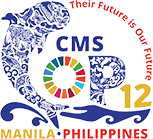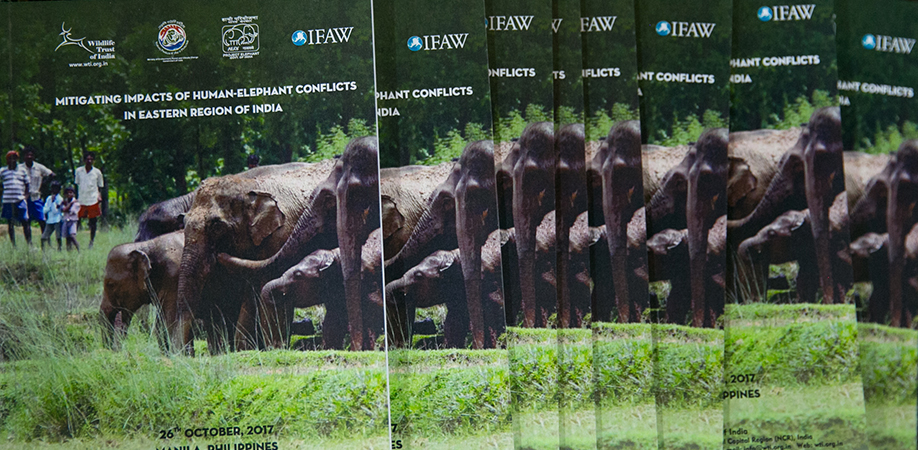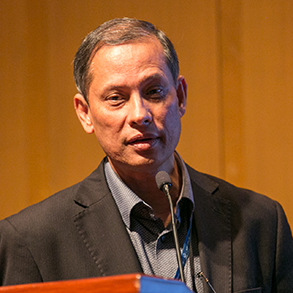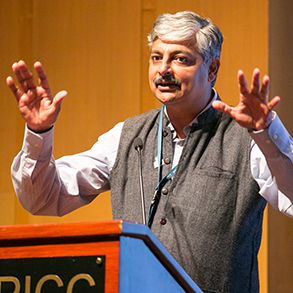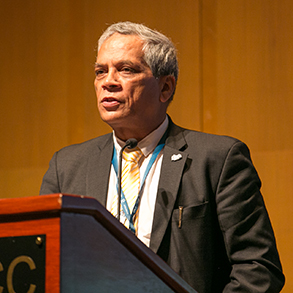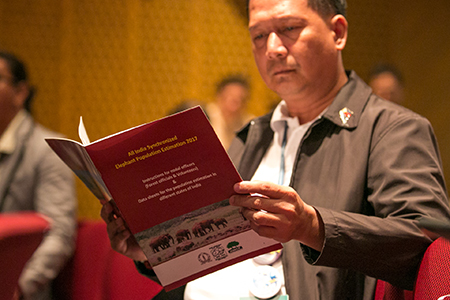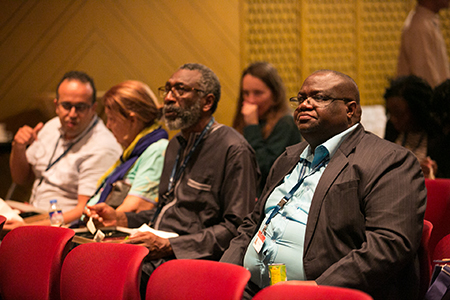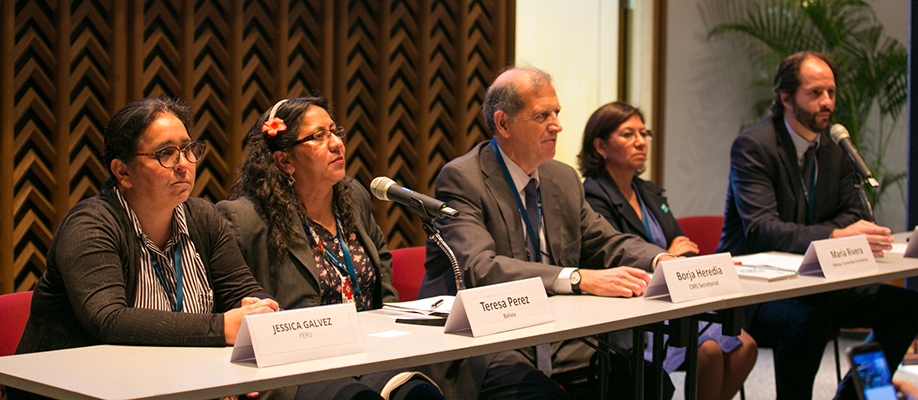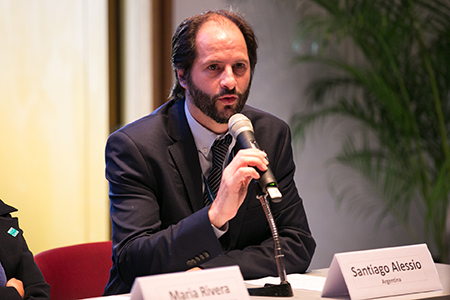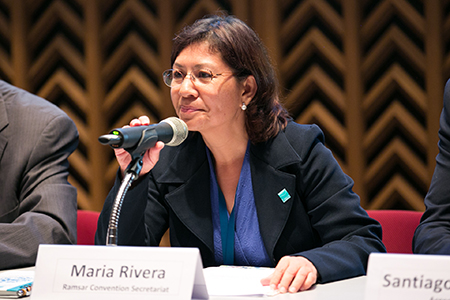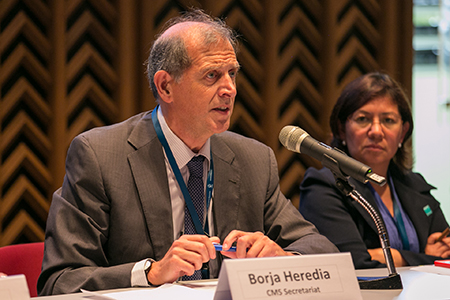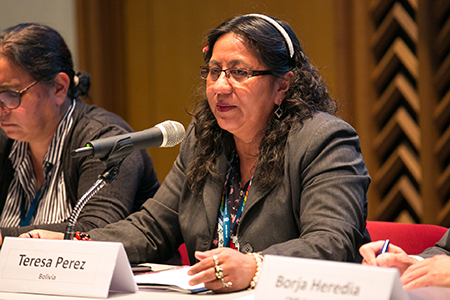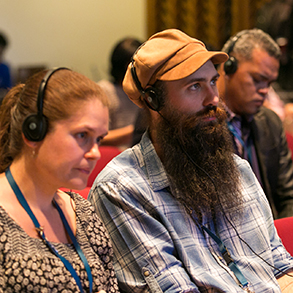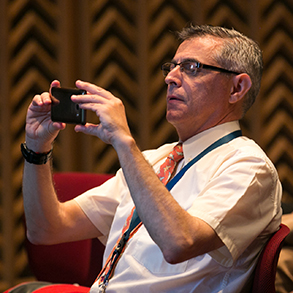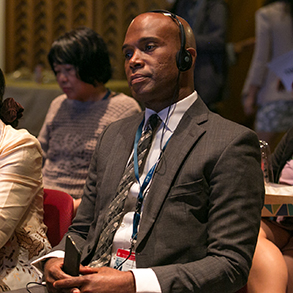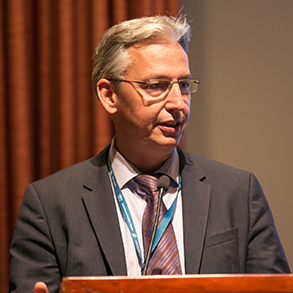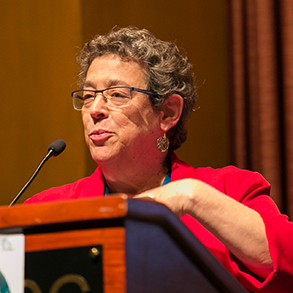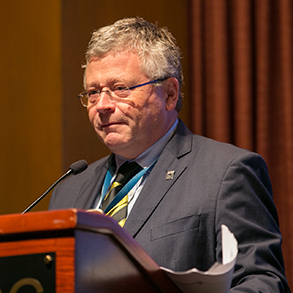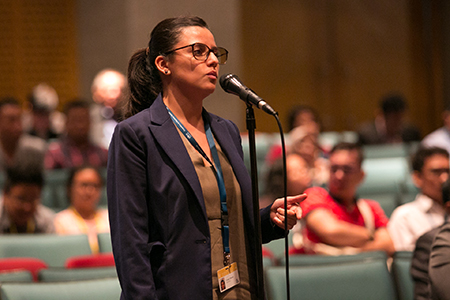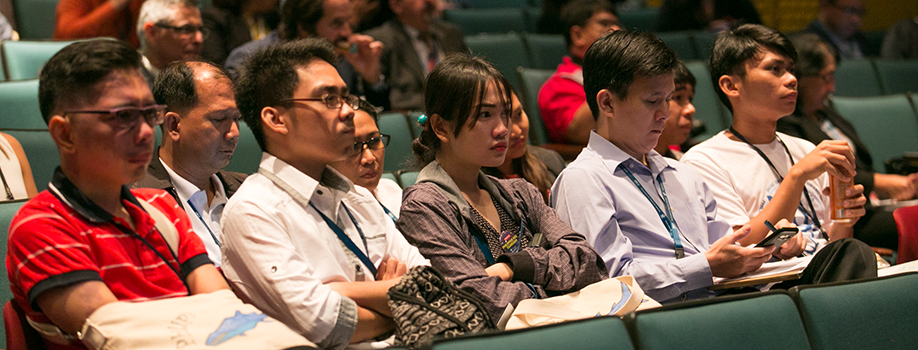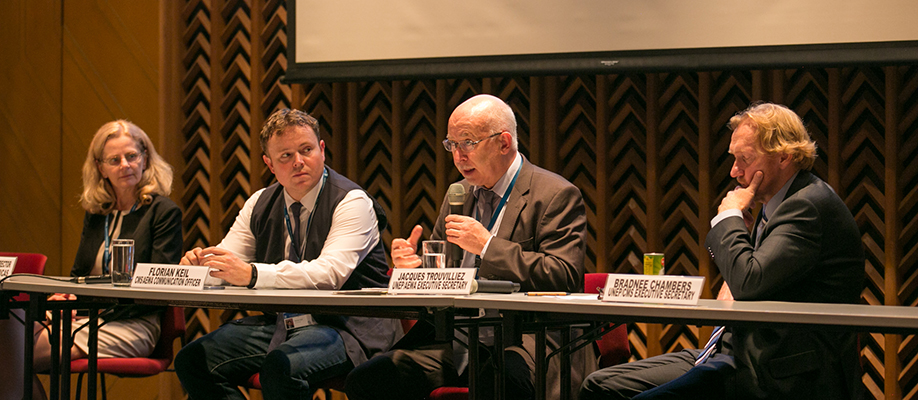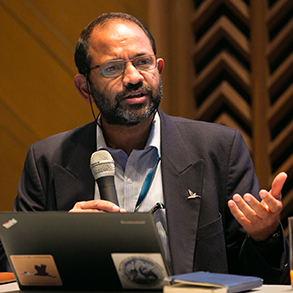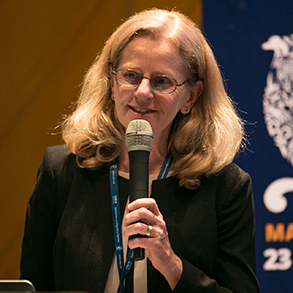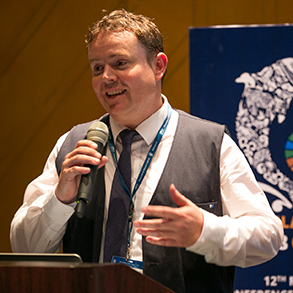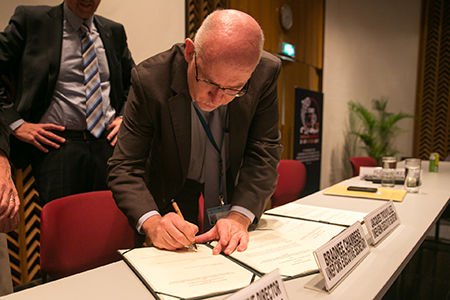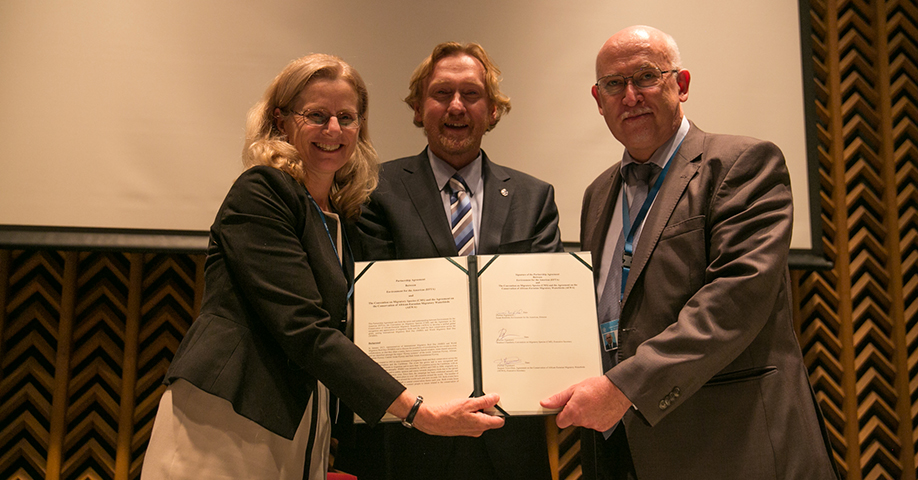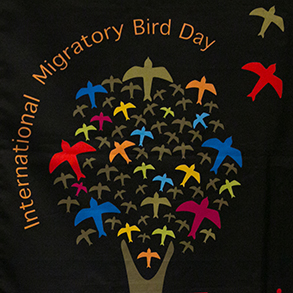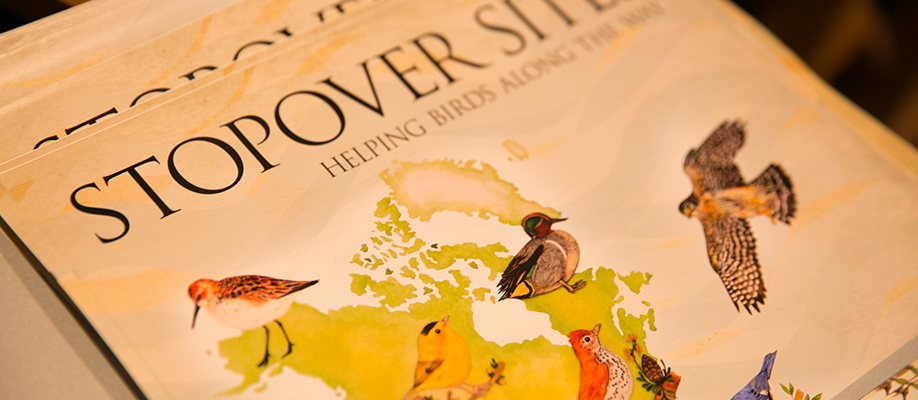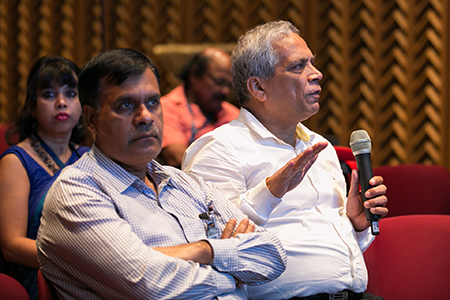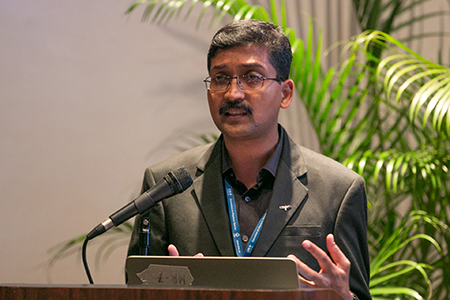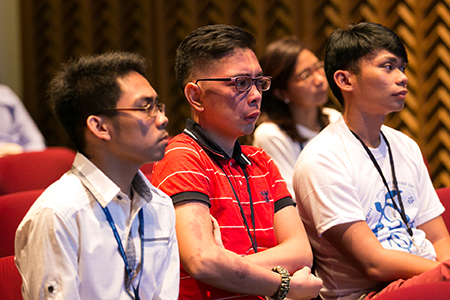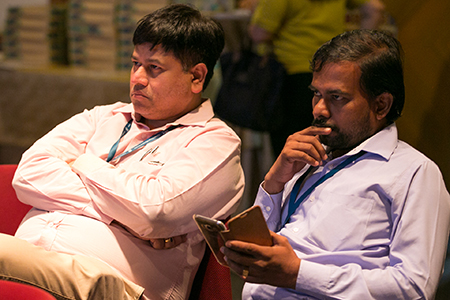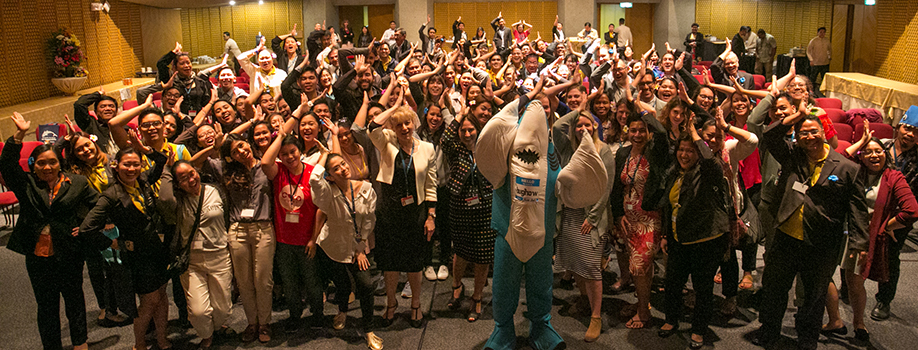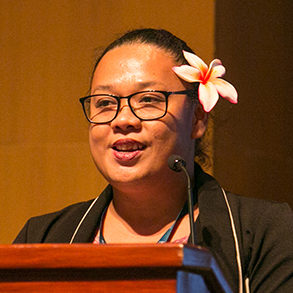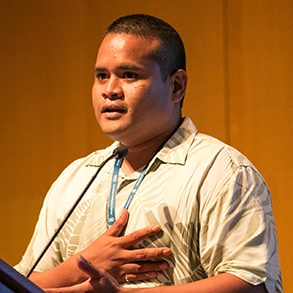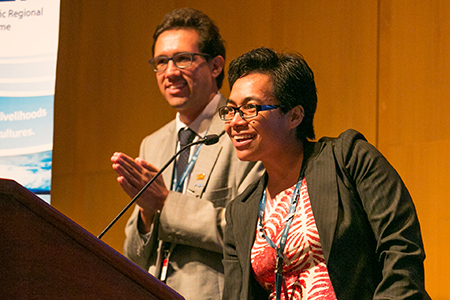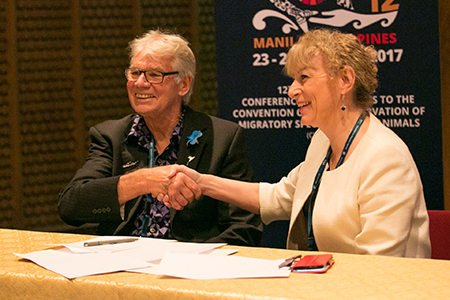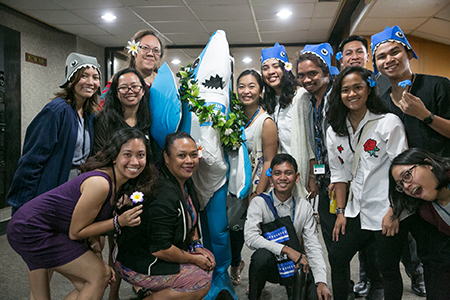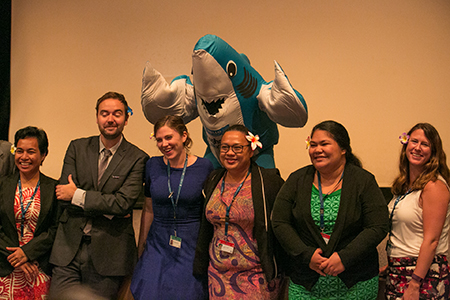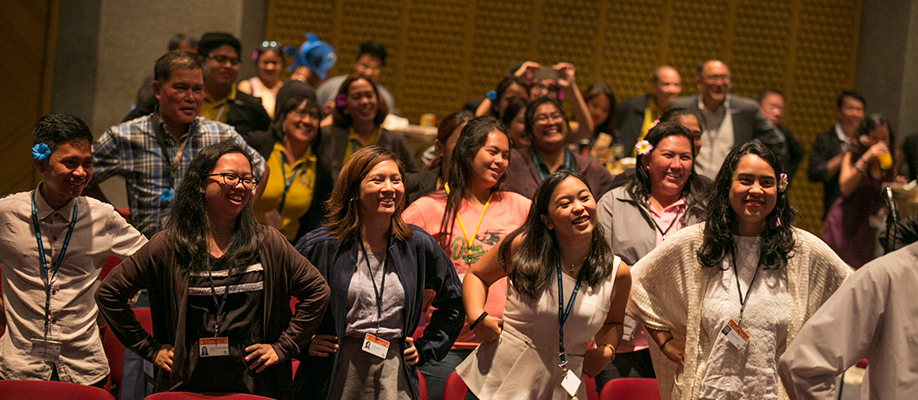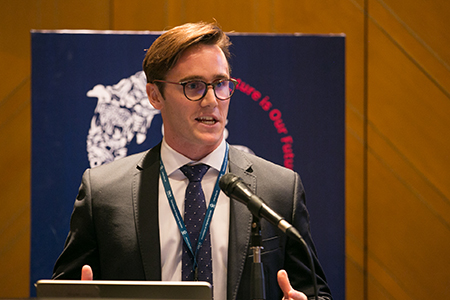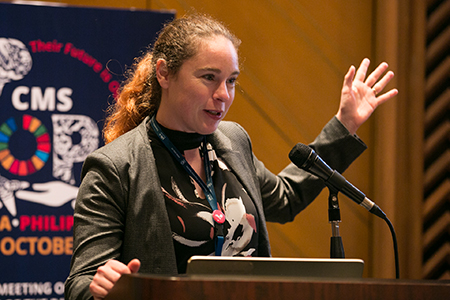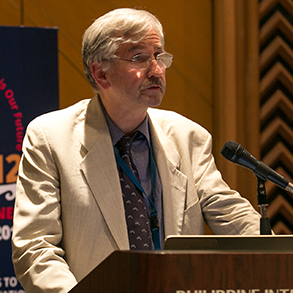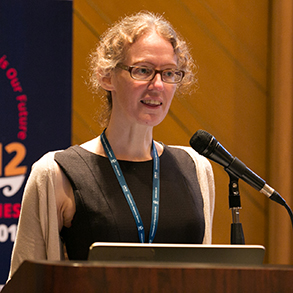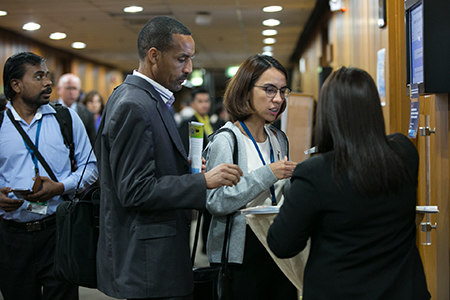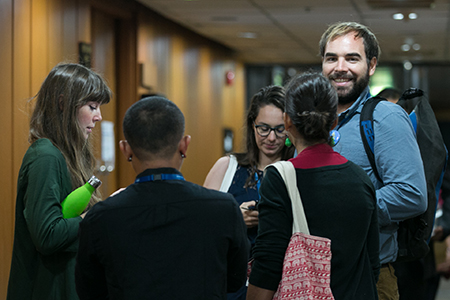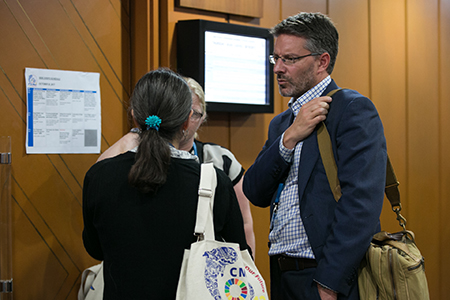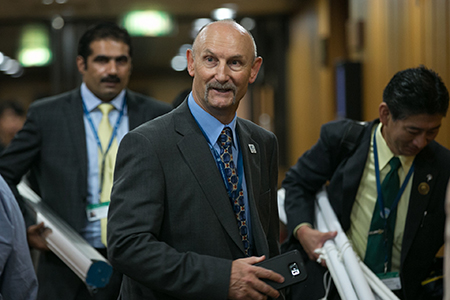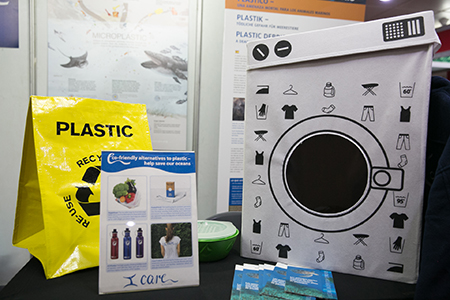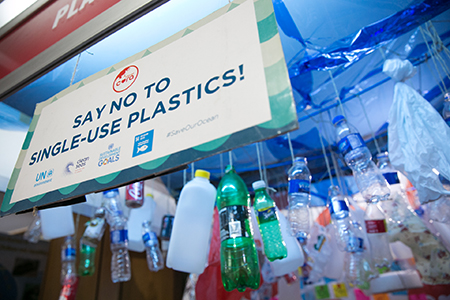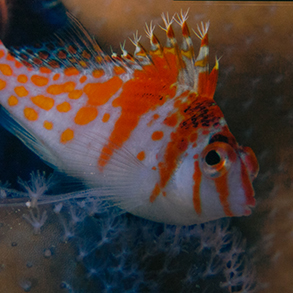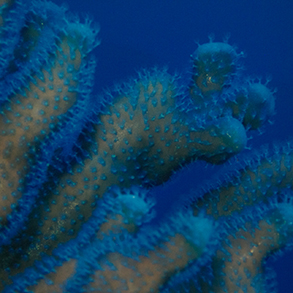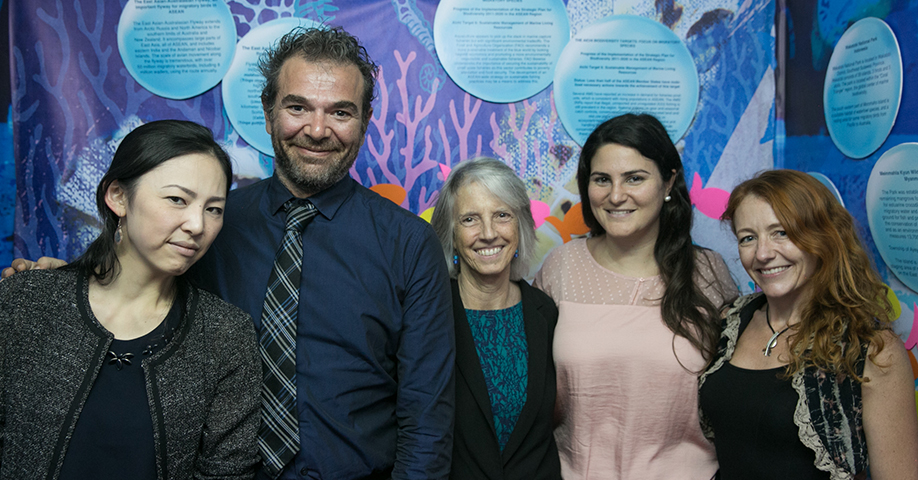Summary
The following events were covered by IISD Reporting Services on Thursday, 26 October 2017:
- Mitigation of Impacts of Human-Elephant Conflicts in Eastern Region of India
- High Andean Wetlands Regional Initiative and High Andean Flamingos - Synergies of the Ramsar Convention on Wetlands and the Convention on the Conservation of Migratory Species of Wild Animals
- Illegal Wildlife Trade and CMS-Listed Species: Opportunities for Action
- Unifying Our Voices for Bird Conservation
- Gangetic Dolphins - Conservation Challenges and Success Stories
- Our Oceans, Our Sharks Future
- Reconciling Energy Developments with Migratory Species Conservation
IISD Reporting Services, through its Earth Negotiations Bulletin on the Side (ENBOTS) Meeting Coverage, is providing daily web coverage from selected side events at CMS COP12.
Photos by IISD/ENB | Kiara Worth
For photo reprint permissions, please follow instructions at our Attribution Regulations for Meeting Photo Usage Page.
Mitigation of Impacts of Human-Elephant Conflicts in Eastern Region of IndiaPresented by the Ministry of Environment, Forests and Climate Change, India, Chief Wildlife Wardens of East Central Landscape of India, Wildlife Trust of India and the International Fund for Animal Welfare (IFAW)
This side event, moderated by Pranja Paramita Panda, Wildlife Trust of India, addressed the Asian elephant and human-elephant conflicts (HECs), which constitute a problem that not only has persisted, but has escalated over time, despite focused elephant conservation and wildlife management efforts in the region.
Vivek Menon, Executive Director and CEO, Wildlife Trust of India, and Chair, IUCN Asian Elephant Specialist Group, stressed that all species populations are included in CITES Appendix I and characterized as endangered by the IUCN Red List of Threatened Species. Emphasizing that approximately only 45,000 Asian elephants currently exist, Menon drew attention to the species’ transboundary movements, focusing on the relevant Jakarta Declaration for Asian Elephant Conservation, and urged for listing in the CMS Appendices in the near future.
R.K. Srivastava, Inspector General of Forests, India, stressed that Asian elephants are responsible for killing 400 to 500 humans per year and for causing property damage, bringing forth retaliatory elephant killings. He addressed, inter alia: the characteristics of HEC in the Eastern Region of India; regional elephant corridors and obstacles caused by human development, including mining operations, high-speed trains and highways; HEC in West Bengal and Jharkhand; policy responses, including interstate committees and regional strategic action plans; and transboundary migration, including between India and Bangladesh.
Discussing key issues of Indo-Bangladesh transboundary elephant conservation, Mohammad Shamsul Azam, Ministry of Environment and Forests, Bangladesh, addressed the status and distribution of resident and non-resident elephants in his country. Presenting a survey estimating population size, identifying routes and corridors, and determining sex ratio, he highlighted as major threats food scarcity and direct elephant loss, and habitat fragmentation and loss due to road construction and human settlement.
Underscoring that HEC is “a huge issue in the region, for both elephants and people,” Matt Collis, IFAW, stressed the need to “make space for the elephants,” and offered success stories from conservation efforts in the border areas between China and Laos, and Kenya and Tanzania. He concluded that a future proposal to list the Asian elephant in the CMS Appendices will have IFAW support.
Materials on display during the event
Mohammad Shamsul Azam, Ministry of Environment and Forests, Bangladesh, discussed national conservation initiatives, including the Elephant Response Teams, habitat improvement programmes, changes in cropping patterns, early warning systems, biological fencing, compensation systems, and communication, education and outreach programmes.
Vivek Menon, Executive Director and CEO, Wildlife Trust of India, and Chair, IUCN Asian Elephant Specialist Group, noted that elephants are simultaneously “deity Ganesha for Hindus, flagship species for conservationists, victims for animal lovers and killers for those faced with conflict.”
R.K. Srivastava, Inspector General of Forests, India, discussed efforts to promote cooperation with Bangladesh for transboundary elephant conservation, noting that similar arrangements must be agreed with Nepal, Bhutan, Myanmar and Sri Lanka.
Participants during the session
Contact:
-
Prajna Paramita Panda (Moderator) | prajna@wti.org.in
More Information:
High Andean Wetlands Regional Initiative and High Andean Flamingos - Synergies of the Ramsar Convention on Wetlands and the Convention on the Conservation of Migratory Species of Wild AnimalsPresented by Ramsar Secretariat and CMS Secretariat
This event, moderated by Santiago D’Alessio, Ministry of Environment and Sustainable Development, Argentina, focused on the connection between High Andean wetlands and flamingos, and the potential for increased synergies under the Ramsar and CMS conventions to enhance conservation efforts for both habitats and species.
Teresa Pérez Chávez, Ministry of Environment and Water, Bolivia, highlighted: deepening and streamlining initiatives to strengthen conservation of important wetlands; the importance of evaluations, characterization studies and monitoring; and concrete measures for joint work between the conventions based on the Action Plan for the Americas Flyways.
Jessica Gálvez-Durand, National Forest and Wildlife Service, Peru, emphasized: threats to wetlands, including contamination; work in her country in zones that currently lack protection; and potential synergies between CMS and Ramsar to address companies that don’t support conservation initiatives.
María Rivera, Ramsar Secretariat, identified potential opportunities for increased synergy, including: overlap in reporting mechanisms, such as national reports; information gleaned from designating areas of national importance; synchronizing updates to Appendices that have relevance to Ramsar sites; and regional processes.
Borja Heredia, CMS Secretariat, focused on: the joint programme of work; the need to address threats to wetlands, including agriculture, mining, unregulated tourism, and climate change; and the value gained from exchanges of experience between the two conventions.
During the discussion, participants considered: threats from invasive species; helping local communities understand that wetlands are a source of life; and the need for scientific tools to conserve wetlands and for technical assistance.
Panel speakers (L-R): Jessica Gálvez-Durand, National Forest and Wildlife Service, Peru; Teresa Pérez Chávez; Ministry of Environment and Water, Bolivia; Borja Heredia, CMS Secretariat; María Rivera, Ramsar Secretariat; and Santiago D’Alessio, Ministry of Environment and Sustainable Development, Argentina
Santiago D’Alessio, Ministry of Environment and Sustainable Development, Argentina, highlighted activities and programmatic links between the two conventions and the importance of continued communication.
Maria Rivera, Ramsar Secretariat, noted that CMS and Ramsar share many of the same focal points.
Borja Heredia, CMS Secretariat, suggested transmitting through CMS the importance of Ramsar and continuing this project in the future.
On ways to improve synergies, Teresa Pérez Chávez, Ministry of Environment and Water, Bolivia, suggested developing potential mechanisms to generate information and mobilize knowledge between CMS and Ramsar.
Participants during the event
Contact:
-
María Rivera (Coordinator) | rivera@ramsar.org
More Information:
Illegal Wildlife Trade and CMS-Listed Species: Opportunities for Action
Presented by the Wildlife Conservation Society (WCS), WWF International, and European Union
This session, moderated by Susan Lieberman, Vice President, WCS, highlighted: the need for and opportunities to combat wildlife trafficking for CMS-listed species; efforts and achievements from CMS-CITES cooperation; and how efforts to combat wildlife trafficking can deliver on the Sustainable Development Goals (SDGs).
Lieberman stressed that illegal wildlife trafficking is a global issue to be addressed in CMS and it is “time for action.” She underscored that CMS implementation can help monitor the problem along the wildlife trade chain from poaching to final sale, including at: poaching sites; landscapes and seascapes in core protected areas; transport nodes where trade flows converge in international borders, ports, and airports; and end-point sales. She noted synergizing CMS-CITES actions can help directly address the SDGs on illegal wildlife trade.
Colman O’Criodain, WWF International, emphasized CMS and CITES are “equal partners” and highlighted successful joint projects on illegal trafficking of migratory species, such as Saiga antelopes, African elephants, and sharks. He highlighted the benefits and opportunities for CMS-CITES collaboration, including: fundraising; collaboration among CMS range states and CITES consumer countries; and ensuring more widespread stakeholder engagement.
Stefan Leiner, Environment Directorate-General, European Commission, introduced the EU Action Plan against Wildlife Trafficking, which prioritizes actions on: prevention by reducing demand and supply, and corruption; enforcement through implementing legislation; and a global partnership using a diplomatic tool to link with trade policy. He highlighted the EU is committed to raising the issue’s profile in the non-environmental arena, not only through financial contributions, but also by supporting global, regional, and national programmes.
In the ensuing discussion, participants noted governments need to: track down growing illegal wildlife trade through the internet; strengthen deterrents by reviewing and modifying legislation; increase awareness of environmental crime; and, raise political commitments, both in environmental and non-environmental arenas.
Stefan Leiner, Environment Directorate-General, European Commission, said “We are committed to collaborate in a holistic, cross-cutting and integrated manner.”
Susan Lieberman, Vice President, WCS, observed “CMS listing alone won’t solve the problem, but it is an important policy tool to raise political commitment.”
Colman O’Criodain, WWF International, noted “Resources are the biggest issue for CMS-CITES collaboration.”
Participants engage in an interactive discussion
Participants during the event
Contact:
-
Susan Lieberman (Moderator) | slieberman@wcs.org
More Information:
Unifying Our Voices for Bird ConservationPresented by Environment for the Americas (EFTA), CMS Secretariat, and the African-Eurasian Migratory Waterbird Agreement (AEWA) Secretariat
This event focused on the signing of an agreement to bring the International Migratory Birds Day (IMBD) and the World Migratory Birds Day (WMBD) together, and join efforts to conserve migratory bird species globally.
Taej Mundkur, Wetlands International, introduced the event and announced that “today brings together something that has been long in the coming, everyone’s been talking about it, and finally it has arrived: two programmes are coming together to enhance global work on migratory birds.”
Susan Bonfield, Executive Director, EFTA, highlighted work with AEWA to strengthen collaboration and bring IMBD and WMBD together into globalized efforts on migratory birds.
Florian Keil, CMS/AEWA, said the new partnership agreement joins IMBD and WMBD to create a global awareness-raising campaign about migratory bird conservation and combines partner resources and strengths, building a global network to engage wider audiences.
Jacques Trouvilliez, Executive Secretary, AEWA, announced that the partnership will have two main campaign targets: children, because “their future is the future of humanity,” and more transboundary events, because migratory bird protection requires international cooperation.
Bradnee Chambers, CMS Executive Secretary, celebrated the partnership as an opportunity to join forces and make the case of why migratory birds matter. He emphasized that the reasons people connect with birds need to be at the center of conservation communication.
Bonfield, Trouvilliez and Chambers signed the partnership, joining the IMBD and the WMBD.
Panel speakers (L-R): Susan Bonfield, Executive Director, Environment for the Americas; Florian Keil, CMS/AEWA; Jacques Trouvilliez, AEWA Executive Secretary; and Bradnee Chambers, CMS Executive Secretary.
Taej Mundkur, Wetlands International, underscored the importance of “good science” feeding into awareness raising for migratory birds, and recognized the use of visually attractive materials by partners in the event.
Susan Bonfield, Executive Director, EFTA, said both WMBD and IMBD have expertise and knowledge to share, and an ability to create a strong campaign for migratory birds by working together.
Florian Keil, CMS/AEWA, explained that WMBD is a joint CMS/AEWA awareness-raising campaign that highlights the need for the conservation of migratory birds.
Jacques Trouvilliez, AEWA Executive Secretary (left), and Bradnee Chambers, CMS Executive Secretary (right) sign the partnership agreement joining the IMBD and the WMBD
Contact:
-
Florian Keil (CMS/AEWA) | contact@worldmigratorybirdday.org
More Information:
Gangetic Dolphins - Conservation Challenges and Success StoriesPresented by the Government of India
This session, moderated by R. Suresh Kumar, Wildlife Institute of India, centered on: Gangetic dolphin population declines in India; actions taken by India; and conservation challenges and success stories.
R. Suresh Kumar, Wildlife Institute of India, explained major threats to Gangetic dolphins, including: habitat fragmentation by dams and barrages; dry-season flow reductions; impacts on habitat suitability by mining and development projects; overharvesting of fish; dolphin mortality due to net entanglement and poaching for oil; and water pollution by chronic and acute exposure to toxins.
He introduced India’s conservation actions to generate reliable information for policy making and reduce dolphin mortality including: multi-dimensional research to improve status assessment; technological solutions such as pingers to hinder approach to fishing nets and alternative oil-bait; and creating citizen conservation networks involving fisher folks and schools to raise awareness.
Kumar noted challenges ahead: improving status assessments; better understanding of Gangetic dolphin ecology; assessing developmental pressures on dolphin populations and relevant mitigation; implementing community-based conservation programmes: and enhancing multi-stakeholder participation.
In the ensuing discussion, participants discussed the need to understand dolphin habitat and distribution, and to improve status surveys and long-term monitoring.
A participant takes notes during the event
Participants ask questions during the event
R. Suresh Kumar, Wildlife Institute of India, said “It’s essential to connect information on dolphin monitoring through citizen conservation networks.”
Participants during the event
Contact:
-
R. Suresh Kumar | suresh.wii@gmail.com
More Information:
Our Oceans, Our Sharks FuturePresented by the Government of Samoa and the Secretariat of the Pacific Regional Environment Programme (SPREP)
This side event, moderated by Nanette Woonton, SPREP, highlighted the connection of the Pacific people with their oceans, addressed shark conservation efforts in the region, and included a ceremonial signing of the ‘Pacific Islands Year of the Whale Declaration’ by the UK.
Juney Ward, SPREP, provided background information about SPREP’s mandate, underscoring the importance of sharks for maintaining healthy and productive marine ecosystems. Warning that 100 million sharks are removed from the oceans every year, mainly for their fins, she highlighted conservation efforts in the Pacific region, including the establishment of shark sanctuaries and urged CMS parties to work collaboratively to provide greater protection to these vulnerable and largely unmanaged species.
Maria Satoa, Ministry of Natural Resources and Environment, Samoa, and Daniel Fernando, Ministry of Sustainable Development and Wildlife, Sri Lanka, presented the proposal to list the blue shark in CMS Appendix II. Satoa addressed the importance of sharks for the Samoan people, noting their significance in terms of culture and tradition, as well as their importance for maintaining healthy reefs. Underscoring that an estimated 20 million blue sharks are killed annualy and their fins remain the most heavily traded of all species in the Hong Kong trade, Fernando discussed management gaps, noting that no protection is warranted under CITES and no measures are in place by regional fisheries management organizations (RFMOs) to ensure that blue sharks are harvested sustainably.
Discussing conservation measures and accomplishments in Palau, McQuinston Temol, Bureau of Marine Resources, Palau, addressed, inter alia, the Palau National Marine Sanctuary, and the Monitoring, Compliance and Surveillance Plan, noting that the sanctuary: fully protects up to 500,000 square kilometers; includes a domestic fishing zone; ends commercial fishing exports by 2020; and strengthens efforts against illegal, unreported and unregulated fishing.
Michael Donoghue, SPREP, introduced the ‘Pacific Islands Year of the Whale Declaration,’ noting that its key features include the impacts of marine debris, development of action plans and coordination between Pacific Ocean islands.
Noting the importance of the moratorium on commercial whaling and the need to work collectively to tackle global threats to cetaceans, Elaine Kendall, Department for Environment, Food and Rural Affairs, UK, signed the ‘Pacific Islands Year of the Whale Declaration’.
Group photo of participants during the event
Juney Ward, SPREP, emphasized that “sharks are not like other fish, they are slow-growing, late to mature and produce few offspring.”
McQuinston Temol, Palau, exclaimed, “Long live the oceans and so will we.”
Nanette Woonton, SPREP, moderated the event, greeting participants in languages from Pacific Island countries.
Maria Satoa, Samoa, and Daniel Fernando, Sri Lanka, presented the proposal to list the blue shark in CMS Appendix II.
Michael Donoghue, SPREP, and Elaine Kendall, UK, shake hands following the signing of the ‘Pacific Islands Year of the Whale Declaration’ by the UK.
Participants during the event
Participants do a traditional South Pacific dance to warm up for the event
Contact:
-
Nanette Woonton (Moderator) | nanettew@sprep.org
More Information:
Reconciling Energy Developments with Migratory Species ConservationPresented by BirdLife International and CMS Energy Task Force
This event, moderated by Edward Perry, Birdlife International/CMS Energy Task Force, focused on the impacts of energy development on migratory species, particularly birds and bats, and presented case studies and possible solutions.
Perry opened the event, highlighting that to mitigate climate change, much of new energy development needs to come from renewable sources, but these can have negative impacts on migratory species, which the CMS Energy Task force aims to reduce by supporting the CMS implementation.
Oliver Schall, Federal Ministry for the Environment, Nature Conservation, Building and Nuclear Safety, Germany, underscored that “we must be successful in fighting climate change for the sake of humans but also other species,” and that proper dialogue is needed between those responsible for nature conservation and energy development to mitigate impacts on biodiversity.
Mohammed Shobrak, Saudi Arabian Wildlife Authority, gave an overview of research taking place in Saudi Arabia on the electrocution and collision of birds with power lines. He said they have identified important flyways and bottleneck areas for species such as the common quail and white stork.
Erin Baerwald, University of Regina, Canada, emphasized that wind energy development is vital to the fight against climate change, but it causes over 500,000 annual bat deaths in the US and Canada alone. She noted that research indicates a 90% decline in hoary bat populations within 50 years, which was “very alarming” given these are conservative estimates.
Emma Marsden, Asian Development Bank (ADB), gave an overview of the energy situation in Asia, and talked about managing migratory species in ADB renewable energy projects, identifying several challenges at the project identification and environmental assessment stages, and concluded that “we need to communicate with the engineers who build plants about the importance of biodiversity.”
Discussions centered around how to best collect data and consider bats properly when carrying out environmental assessments; whether wind turbines attract bats; and most effective ways to enact policy solutions.
View of the room during the event
Edward Perry, Birdlife International/CMS Energy Task Force, said the goal of the Task Force is simple but ambitious: avoid negative impacts on migratory species from energy developments.
Erin Baerwald, University of Regina, Canada, noted many species of bats are already in decline, and wind turbines kill prime breeding-age adults, which further slows the recovery potential of populations.
Oliver Schall, Federal Ministry for the Environment, Nature Conservation, Building and Nuclear Safety, Germany, said that the 2050 energy goals will not be met without wind power, so wind farms that are compatible with environmental and biodiversity requirements are needed.
Emma Marsden, ADB, said there is limited awareness by government officials and operators about environmental impacts on biodiversity from renewable energy, which offers an opportunity for ADB and partners to raise awareness.
Mohammed Shobrak, Saudi Arabian Wildlife Authority, said red sea coastal areas are important for both humans and migratory species.
Contact:
-
Edward Perry (Moderator) | Edward.perry@birdlife.org
More Information:
Around the Venue
Around the side events venue
Participants between events
Delegates wear a virtual reality mask to experience sealife (left) and gorilla trekking (right)
International Institute for Sustainable Development (IISD) Earth Negotiations Bulletin (ENB) team covering side events throughout the week (L-R): Ikuho Miyazawa, Japan, Asterios Tsioumanis, Greece; Teya Penniman, US; Iliana Cardenes, Spain; and Kiara Worth, South Africa
